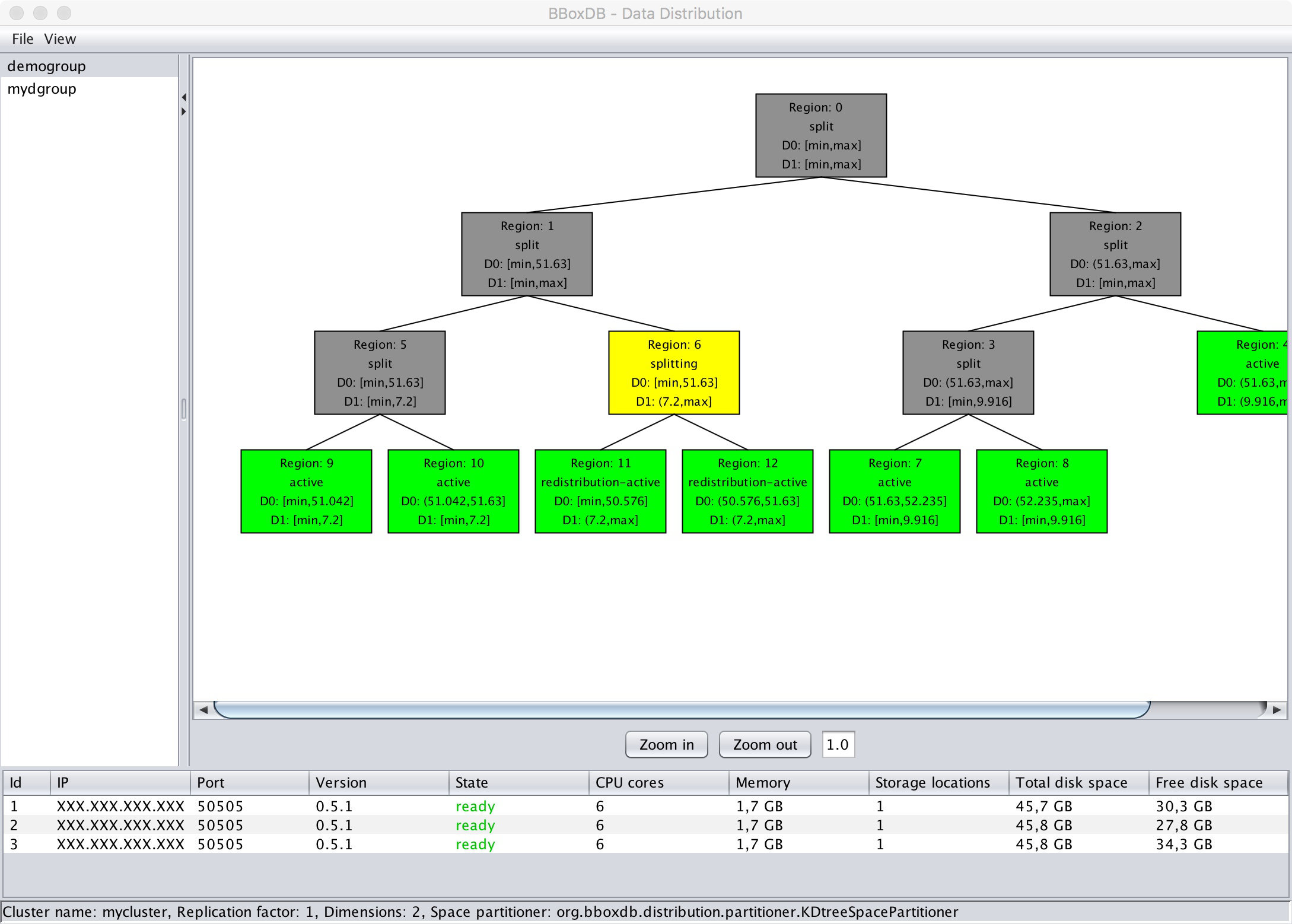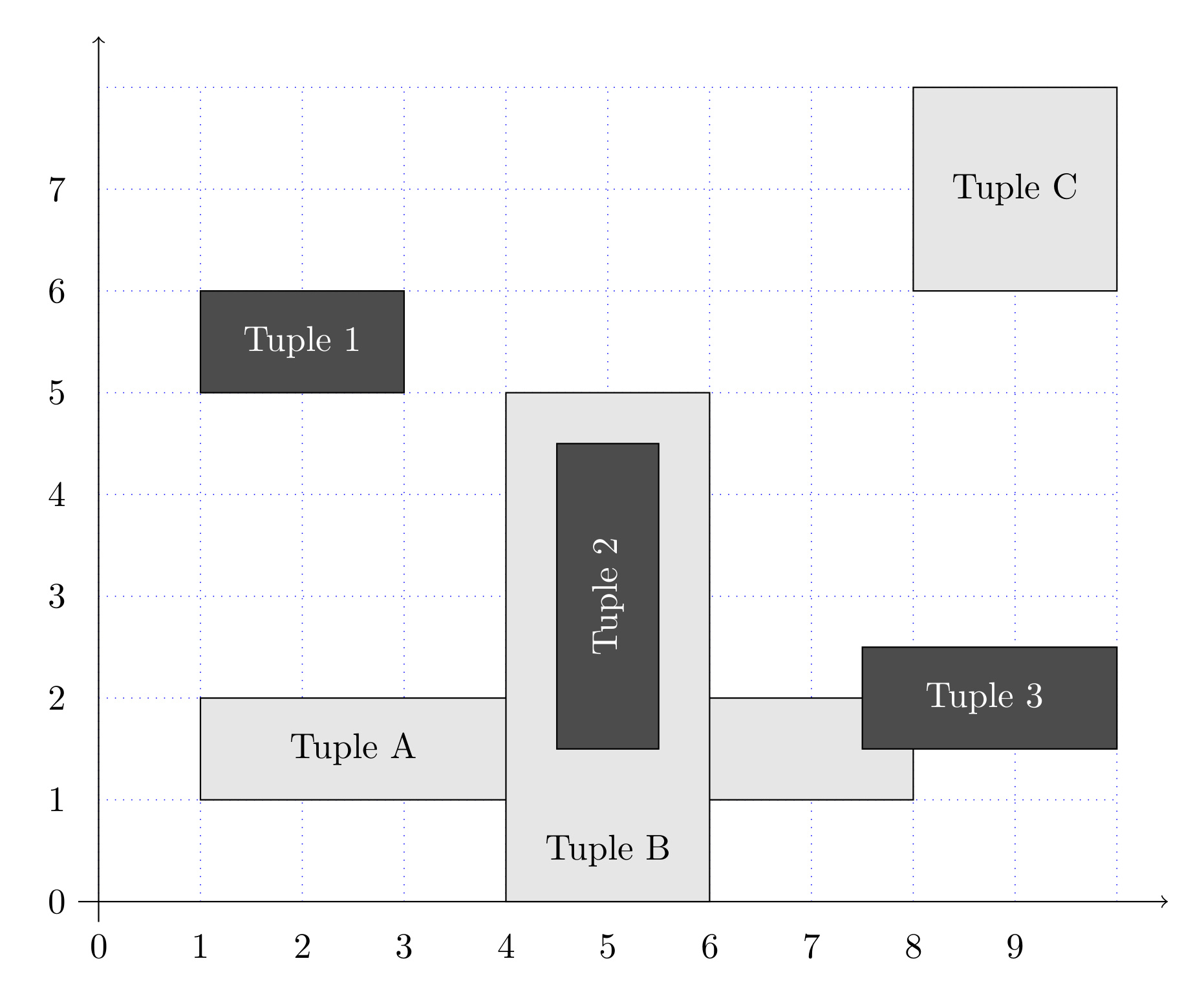Getting started
An Example with OpenStreetMap Data
This section covers an example to demonstrate the basic functionality of BBoxDB. Data from the OpenStreetMap project is fetched, converted, and imported into a table. Then, some queries are executed on this data set. In this example, the spatial data of Germany is used. Then, all trees around the famous Alexanderplatz (a public square in Berlin) are fetched.
Viewing the discovered BBoxDB instances
Before the data is imported, it is useful to verify that all started instances of BBoxDB are discovered and ready. This task can be done via the ‘show_instances’ action of the CLI.
$ $BBOXDB_HOME/bin/cli.sh -action show_instances
Connecting to BBoxDB cluster... [Established]
Show all discovered BBoxDB instances
#######
DistributedInstance [ip=192.168.1.181, port=50505, version=0.3.1, state=READY]
DistributedInstance [ip=192.168.1.189, port=50505, version=0.3.1, state=READY]
DistributedInstance [ip=192.168.1.192, port=50505, version=0.3.1, state=READY]
DistributedInstance [ip=192.168.1.199, port=50505, version=0.3.1, state=READY]
DistributedInstance [ip=192.168.1.202, port=50505, version=0.3.0, state=UNKNOWN]
#######
In our example, the cluster consists of 5 BBoxDB instances. The instances on the first four systems are ready. The instance of the system 192.168.1.202 is not available at the moment.
Downloading and Converting Data
The first step is to download and to convert the data set. The data is stored in a format called ‘Protocolbuffer Binary Format’. BBoxDB ships with a converter that converts this format into GeoJSON. You will find more details about the data converter here.
The conversion can be executed with the following commands:
$ wget http://download.geofabrik.de/europe/germany-latest.osm.pbf
$ cd $BBOXDB_HOME
$ $BBOXDB_HOME/bin/osm_data_converter.sh -input /path/to/germany-latest.osm.pbf -backend bdb -workfolder /tmp -output /path/to/outputdir/germany
After the conversion has finished, the data in the output directory looks like this:
$ ls -l /path/to/outputdir/germany
-rw-rw-r-- 1 nidzwetzki nidzwetzki 7520947178 Apr 21 23:18 BUILDING
-rw-rw-r-- 1 nidzwetzki nidzwetzki 3850151857 Apr 21 23:18 ROAD
-rw-rw-r-- 1 nidzwetzki nidzwetzki 26251267 Apr 21 23:18 TRAFFIC_SIGNAL
-rw-rw-r-- 1 nidzwetzki nidzwetzki 184394469 Apr 21 23:18 TREE
-rw-rw-r-- 1 nidzwetzki nidzwetzki 159681265 Apr 21 23:18 WATER
-rw-rw-r-- 1 nidzwetzki nidzwetzki 82794367 Apr 21 23:18 WOOD
The input is split up into multiple files and converted into GeoJSON. The file ‘BUILDING’ (20,828,427 objects) contains all buildings in Germany; the file ‘TREE’ contains all trees (1,118,516 objects) of Germany.
Importing Data
The file ‘TREE’ is now imported into BBoxDB. However, a 2-dimensional distribution group needs to be created first. The distribution group in this example is called ‘mydgroup’. The data of the trees will be stored in the table ‘mydgroup_germanytree’.
The tasks can be accomplished with the following two commands:
$ $BBOXDB_HOME/bin/cli.sh -action create_dgroup -dgroup mydgroup -replicationfactor 2 -dimensions 2
$ $BBOXDB_HOME/bin/cli.sh -action create_table -table mydgroup_germanytree
$ $BBOXDB_HOME/bin/cli.sh -action import -file /path/to/TREE -format geojson -table mydgroup_germanytree
Fetching Data
Now, the stored data can be accessed. The data importer uses a consecutive number for each object. Therefore, to fetch the object with the key ‘120’, the following command can be used:
$ $BBOXDB_HOME/bin/cli.sh -action query_key -table mydgroup_germanytree -key 120
Connecting to BBoxDB cluster... [Established]
Executing key query..
Key 120, BoundingBox=[52.546123300000005:52.546123300000005,13.350283200000002:13.350283200000002], value={"geometry":{"coordinates":[52.546123300000005,13.350283200000002],"type":"Point"},"id":405400527,"type":"Feature","properties":{"natural":"tree","leaf_cycle":"deciduous","leaf_type":"broadleaved"}}, version timestamp=1493788229600008
Query done
The tuple is loaded from BBoxDB and printed on the console. The Key, the Bounding Box and the GeoJSON data (the value) of the tuple are printed. The area around the Alexanderplatz can be roughly expressed by a square with the following coordinates: 13.410, 52.520 for the lower left corner, and 13.415, 52.525 for the upper right corner. The following command can be used to fetch all trees which are inside of the square:
$BBOXDB_HOME/bin/cli.sh -action query_range -table mydgroup_germanytree -bbox [[52.520,52.525]:[13.410,13.415]]
[...]
Key 37587, BoundingBox=[52.4558036:52.4558036,13.4450991:13.4450991], value={"geometry":{"coordinates":[52.4558036,13.4450991],"type":"Point"},"id":3451433771,"type":"Feature","properties":{"natural":"tree","leaf_cycle":"deciduous","leaf_type":"broadleaved"}}, version timestamp=1493788236276020
Key 37588, BoundingBox=[52.455812:52.455812,13.440128000000001:13.440128000000001], value={"geometry":{"coordinates":[52.455812,13.440128000000001],"type":"Point"},"id":3451433774,"type":"Feature","properties":{"natural":"tree","leaf_cycle":"deciduous","leaf_type":"broadleaved"}}, version timestamp=1493788236276022
Key 37589, BoundingBox=[52.455847000000006:52.455847000000006,13.446559800000001:13.446559800000001], value={"geometry":{"coordinates":[52.455847000000006,13.446559800000001],"type":"Point"},"id":3451433775,"type":"Feature","properties":{"natural":"tree","leaf_cycle":"deciduous","leaf_type":"broadleaved"}}, version timestamp=1493788236276024
Query done
Viewing the Data Distribution
BBoxDB distributes the data of a distribution group across multiple systems. Depending on the configuration, the imported data could be already spread across several systems. This can be viewed via CLI or via GUI.
Via the Command Line Interface (CLI)
To view how the data of the distribution group mydgroup is spread, the following command can be used:
$ $BBOXDB_HOME/bin/cli.sh -action show_dgroup -dgroup mydgroup
Region 0, Bounding Box=Dimension:0 [min,max], Dimension:1 [min,max], State=SPLIT, Systems=[192.168.1.183:50505, 192.168.1.191:50505]
Region 1, Bounding Box=Dimension:0 [min,52.5145621], Dimension:1 [min,max], State=ACTIVE, Systems=[192.168.1.189:50505, 192.168.1.192:50505]
Region 2, Bounding Box=Dimension:0 (52.5145621,max], Dimension:1 [min,max], State=ACTIVE, Systems=[192.168.1.181:50505, 192.168.1.199:50505]
[....]
It can be seen that the data of region 0 is split. Region 1 stores the data that belongs to the bounding box Dimension:0 [min,52.5145621], Dimension:1 [min,max]. Region 2 stores the remaining data. The region 1 is stored on the systems ‘192.168.1.189:50505, 192.168.1.192:50505’ the region 2 is stored on the systems ‘192.168.1.181:50505, 192.168.1.199:50505’.
Via the Graphical User Interface (GUI)
To use the GUI, please use the following command:
$ $BBOXDB_HOME/bin/gui.sh

After connecting to BBoxDB, the GUI shows all discovered distribution groups on the left side. On the bottom, all known BBoxDB-nodes and their state are shown. In the middle of the GUI, the K-D Tree of the distribution group is printed. For two-dimensional distribution groups, which work with WGS84 coordinates, an overlay for OpenStreetMap data can be displayed.

Working with the tuple history
BBoxDB can store a history for each tuple. The history stores a certain amount of old values for each tuple. To use this function, the corresponding table must be allowed to contain duplicates for keys. To prevent the tables from becoming infinitely large, BBoxDB can automatically delete old tuples. This is done when more than a certain amount of versions for a key are contained in the table or then the tuples become older than a certain amount of time (time to live).
In the following example, a table is created that contains up to three versions for a certain key:
$ $BBOXDB_HOME/bin/cli.sh -action create_dgroup -dgroup mydgroup -replicationfactor 1 -dimensions 2
$ $BBOXDB_HOME/bin/cli.sh -action create_table -table mydgroup_data -duplicates true -versions 3
Now five versions for the key are inserted with the values value1, value2, value3, value4 and value5:
$ $BBOXDB_HOME/bin/cli.sh -action insert -table mydgroup_data -key key1 -bbox [[1,2]:[1,2]] -value value1
$ $BBOXDB_HOME/bin/cli.sh -action insert -table mydgroup_data -key key1 -bbox [[1,2]:[1,2]] -value value2
$ $BBOXDB_HOME/bin/cli.sh -action insert -table mydgroup_data -key key1 -bbox [[1,2]:[1,2]] -value value3
$ $BBOXDB_HOME/bin/cli.sh -action insert -table mydgroup_data -key key1 -bbox [[1,2]:[1,2]] -value value4
$ $BBOXDB_HOME/bin/cli.sh -action insert -table mydgroup_data -key key1 -bbox [[1,2]:[1,2]] -value value5
The key query returns the three most recent versions for the key:
$ $BBOXDB_HOME/bin/cli.sh -action query_key -table mydgroup_data -key key1
Connecting to BBoxDB cluster... [Established]
Executing key query..
Key key1, BoundingBox=[[1.0,2.0]:[1.0,2.0]], value=value3, version timestamp=1509699605215000
Key key1, BoundingBox=[[1.0,2.0]:[1.0,2.0]], value=value4, version timestamp=1509699607483000
Key key1, BoundingBox=[[1.0,2.0]:[1.0,2.0]], value=value5, version timestamp=1509699609644000
Query done
The query returns three different versions for the key key1. The tuples are sorted by the version timestamp, and the most recent version of the tuple (with the value of value5) is shown at the last position.
Now, the tuple for the key is deleted and the key query is executed again. It can be seen that there are still three versions stored for this key. The version with the value “value3” has been removed, and a new version (which says that the tuple was deleted) has been added.
$ $BBOXDB_HOME/bin/cli.sh -action delete -table mydgroup_data -key key1
$ $BBOXDB_HOME/bin/cli.sh -action query_key -table mydgroup_data -key key1
Connecting to BBoxDB cluster... [Established]
Executing key query..
Key key1, BoundingBox=[[1.0,2.0]:[1.0,2.0]], value=value4, version timestamp=1509699607483000
Key key1, BoundingBox=[[1.0,2.0]:[1.0,2.0]], value=value5, version timestamp=1509699609644000
Key key1, DELETED, version timestamp=1509703784058000
Query done
Working with continuous bounding box queries
BBoxDB supports continuous bounding box queries. As soon as the query is executed, all tuples that are inserted within the bounding box are captured by this query. To demonstrate this, the continuous bounding box query is started on one console:
console1> $BBOXDB_HOME/bin/cli.sh -action query_continuous -table mydgroup_data -bbox [[0,5]:[0,5]]
Connecting to BBoxDB cluster... [Established]
Executing continuous bounding box query...
On another console, a new tuple is inserted in the query bounding box:
# Tuple (bbox completely contained in query)
console2> $BBOXDB_HOME/bin/cli.sh -action insert -table mydgroup_data -key key1 -bbox [[1,2]:[1,2]] -value value1
# Tuple (bbox not contained in query)
console2> $BBOXDB_HOME/bin/cli.sh -action insert -table mydgroup_data -key key2 -bbox [[10,15]:[10,15]] -value value2
# Tuple (bbox partially contained in query)
console2> $BBOXDB_HOME/bin/cli.sh -action insert -table mydgroup_data -key key3 -bbox [[2,10]:[2,10]] -value value3
As soon as the three tuples are inserted, the query reports two tuples:
console1> $BBOXDB_HOME/bin/cli.sh -action query_continuous -table mydgroup_data -bbox [[0,5]:[0,5]]
Connecting to BBoxDB cluster... [Established]
Executing continuous bounding box query...
Key key1, BoundingBox=[[1.0,2.0]:[1.0,2.0]], value=value1, version timestamp=1510325620579000
Key key3, BoundingBox=[[2.0,10.0]:[2.0,10.0]], value=value3, version timestamp=1510325620643000
Executing a join
In this example, a join on two tables is executed. The join operation returns all tuples of two or more tables in the same distribution group with overlapping bounding boxes. As the first step in this example, a 2-dimensional distribution group is created with the two tables _ mydgroup_table1_ and mydgroup_table2. Afterward, three tuples are inserted in both tables.
# Prepare distribution group and tables
$ $BBOXDB_HOME/bin/cli.sh -action create_dgroup -dgroup mydgroup -replicationfactor 1 -dimensions 2
$ $BBOXDB_HOME/bin/cli.sh -action create_table -table mydgroup_table1
$ $BBOXDB_HOME/bin/cli.sh -action create_table -table mydgroup_table2
# Tuples of table1
$ $BBOXDB_HOME/bin/cli.sh -action insert -table mydgroup_table1 -key tuple_a -bbox [[1,8]:[1,2]] -value value_a
$ $BBOXDB_HOME/bin/cli.sh -action insert -table mydgroup_table1 -key tuple_b -bbox [[4,6]:[0,5]] -value value_b
$ $BBOXDB_HOME/bin/cli.sh -action insert -table mydgroup_table1 -key tuple_c -bbox [8,10]:[8,10]] -value value_c
# Tuples of table2
$ $BBOXDB_HOME/bin/cli.sh -action insert -table mydgroup_table2 -key tuple_1 -bbox [[1,3]:[5,6]] -value value_1
$ $BBOXDB_HOME/bin/cli.sh -action insert -table mydgroup_table2 -key tuple_2 -bbox [[4.5,5.5]:[1.5,4.5]] -value value_2
$ $BBOXDB_HOME/bin/cli.sh -action insert -table mydgroup_table2 -key tuple_3 -bbox [[7.5,10]:[1.5,2.5]] -value value_3
After the data is inserted, we have a data distribution like shown in the following figure:

The tuple Tuple A intersects with Tuple 2 and with Tuple 3; tuple Tuple 2 is contained in Tuple B completely. Now, the join can be performed with the following command. The join returns the previous three tuples, which have intersecting bounding boxes.
Notice: Please note that the grid in the image is used only to show where the tuples are located in space. The grid does not indicate how the space is divided into distribution regions; this is done by the space partitioner dynamically.
$ $BBOXDB_HOME/bin/cli.sh -action query_join -table mydgroup_table1:mydgroup_table2 -bbox [[0,10]:[0,8]]
Executing join query...
===============
Joined bounding box: [[4.5,5.5]:[1.5,2.0]]
Table: mydgroup_table1
Tuple: Key tuple_a, BoundingBox=[[1.0,8.0]:[1.0,2.0]], value=value_a, version timestamp=1519506380682000
Table: mydgroup_table2
Tuple: Key tuple_2, BoundingBox=[[4.5,5.5]:[1.5,4.5]], value=value_2, version timestamp=1519506388615000
===============
===============
Joined bounding box: [[7.5,8.0]:[1.5,2.0]]
Table: mydgroup_table1
Tuple: Key tuple_a, BoundingBox=[[1.0,8.0]:[1.0,2.0]], value=value_a, version timestamp=1519506380682000
Table: mydgroup_table2
Tuple: Key tuple_3, BoundingBox=[[7.5,10.0]:[1.5,2.5]], value=value_3, version timestamp=1519506390606000
===============
===============
Joined bounding box: [[4.5,5.5]:[1.5,4.5]]
Table: mydgroup_table1
Tuple: Key tuple_b, BoundingBox=[[4.0,6.0]:[0.0,5.0]], value=value_b, version timestamp=1519506382772000
Table: mydgroup_table2
Tuple: Key tuple_2, BoundingBox=[[4.5,5.5]:[1.5,4.5]], value=value_2, version timestamp=1519506388615000
===============
Join done
What’s Next
- Visit our website
- Read the documentation.
- Integrate the BBoxDB Client into your own applications. You find an example and some documentation here.
- Follow us on Twitter to stay informed.
- Read the source code.
- Report Bugs here.
- Submit patches.